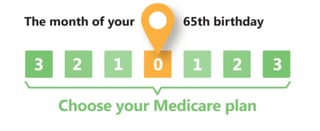Do You Understand the Basics of Medicare?
Medicare can be complex, so it’s important to learn as much as you can as you begin thinking about enrolling in Medicare health insurance. This quiz can help you see how much you know about Medicare and determine what areas you need to research more.
Q: What does Original Medicare cover?
A: Original Medicare covers Part A (hospital insurance) and Part B (medical insurance). However, it only covers 80 percent of your medical bills. You are left to pay for the remaining 20 percent with no limit to your out-of-pocket costs. In addition, Original Medicare does not cover Part D (prescription drugs) or extra benefits like dental or vision. That’s why many who are eligible for Medicare also choose to add additional coverage to help cover what Original Medicare does not.
Q: What options do I have for receiving Medicare?
A: There are three common options when choosing a Medicare plan. Each option has pros and cons, and the best choice for you depends on your situation.
Option 1: Add a Part D Prescription Plan to Original Medicare

To pick up where Original Medicare leaves off, one option is to purchase a private stand-alone Part D prescription drug plan. These plans are offered by private insurance companies and the monthly premium for these plans can vary based on how much they cover. Though this option will help cover some of the cost of prescriptions, it still leaves you exposed for the 20 percent that Original Medicare doesn’t cover.
Option 2: Add a Part D Prescription Plan and a Supplement to Original Medicare

To cover that 20 percent Original Medicare doesn’t cover as well as prescription drugs, some people purchase a Part D plan and a Medicare supplement. Supplements can be expensive though, and you will be paying multiple premiums to multiple companies each month. Medicare supplements follow the “pay now” payment method, where you pay the same amount every month even if you don’t see your doctor or need medical care. It’s also important to note that extra benefits like dental and vision are not offered.
For more details on supplements, visit our Medicare Learning Center and check out Pros and Cons of Medicare Supplements.
Option 3: Join a Medicare Advantage Plan (also known as Part C)

For an “all-in-one” plan that offers comprehensive coverage, many choose a Medicare Advantage plan. These plans cover all the things Original Medicare covers, plus the 20 percent it doesn’t. In addition, many Medicare Advantage plans include Part D prescription drug coverage and valuable extras like dental and vision benefits at no extra cost. Also, some Medicare Advantage plans offer $0 premiums and low copays. They also include a built-in “safety net” that puts a limit on the amount you will have to pay out of your own pocket each year for covered medical expenses.
To learn more about what each part of Medicare covers, check out our blog "The ABCs and Ds of Medicare." Interested in more details about coverage options? Visit our Medicare Learning Center and check out 3 Most Common Medicare Options.
Q: How much will I pay each month for Medicare?
A: It depends on the plan you choose. Here are some average estimates.
Option 1: Add a Part D Prescription Plan to Original Medicare
Part A $0
Part B Premium $135.50
Part D Premium $57
Total $192.50
Option 2: Add a Part D Prescription Plan and a Supplement to Original Medicare
Part A $0
Part B Premium $135.50
Part D Premium $57
Supplement Premium $183
Total $375.50
Option 3: Join a Medicare Advantage Plan (also known as Part C)
Part A $0
Part B Premium $135.50
Part D Premium $0
Dental $0
Vision $0
Total $135.50
Q: When can I enroll in Medicare?
A: Medicare has different enrollment periods, depending on your specific circumstances and the type of plan you choose. Eligibility requirements differ for each of these periods.
The Initial Enrollment Period is the seven-month window when you first become eligible for Medicare. It starts three months before your 65th birthday and is open up to three months after you turn 65.
The General Enrollment Period is January 1-March 31, if you happen to miss your seven-month Initial Enrollment Period.
The Special Enrollment Period is for specific circumstances. For example, if you or your spouse is currently 65, and one of you has health insurance through an employer or union, you will have an eight-month Special Enrollment Period that starts when your group health insurance based on employment ends.
The Annual Enrollment Period runs from October 15-December 7 each year. This is when you can switch from your current Medicare plan to a different plan.
The Open Enrollment Period runs from January 1-March 31. This is limited to Medicare Advantage enrollees. You can make a one-time election to leave your plan and switch to another Medicare Advantage plan or Original Medicare. You can also add or drop Part D coverage during this time.
For more information about Medicare enrollment periods, check out our blog "Medicare Enrollment Periods Explained."
Essence Healthcare
